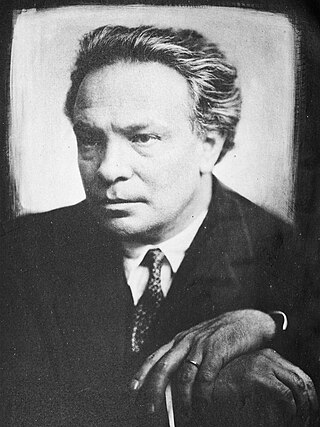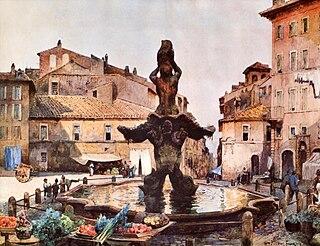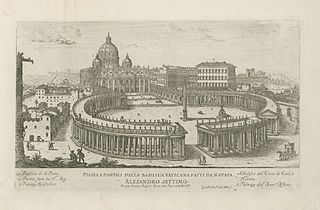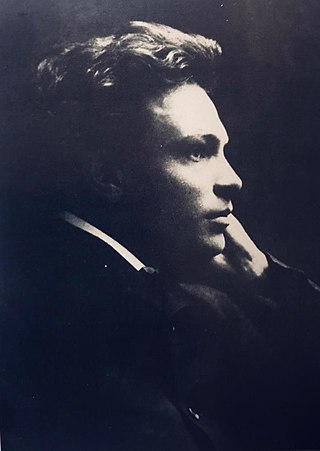
The Trevi Fountain is an 18th-century fountain in the Trevi district in Rome, Italy, designed by Italian architect Nicola Salvi and completed by Giuseppe Pannini in 1762 and several others. Standing 26.3 metres (86 ft) high and 49.15 metres (161.3 ft) wide, it is the largest Baroque fountain in the city and one of the most famous fountains in the world.

Ottorino Respighi was an Italian composer, violinist, teacher, and musicologist and one of the leading Italian composers of the early 20th century. His compositions range over operas, ballets, orchestral suites, choral songs, chamber music, and transcriptions of Italian compositions of the 16th–18th centuries, but his best known and most performed works are his three orchestral tone poems which brought him international fame: Fountains of Rome (1916), Pines of Rome (1924), and Roman Festivals (1928).

Fontana del Tritone is a seventeenth-century fountain in Rome, by the Baroque sculptor Gian Lorenzo Bernini. Commissioned by his patron, Pope Urban VIII, the fountain is located in the Piazza Barberini, near the entrance to the Palazzo Barberini that Bernini helped to design and construct for the Barberini, Urban's family. This fountain should be distinguished from the nearby Fontana dei Tritoni by Carlo Francesco Bizzaccheri in Piazza Bocca della Verità which features two Tritons.

The Villa Giulia is a villa in Rome, Italy. It was built by Pope Julius III in 1551–1553 on what was then the edge of the city. Today it is publicly owned, and houses the Museo Nazionale Etrusco, a collection of Etruscan art and artifacts.
Roman Festivals, P 157 is a tone poem in four movements for orchestra completed in 1928 by the Italian composer Ottorino Respighi. It is the last of his three tone poems about Rome, following Fountains of Rome (1916) and Pines of Rome (1924), which he referred to as a triptych. Each movement depicts a scene of celebration in ancient and contemporary Rome, specifically gladiators battling to the death, the Christian Jubilee, a harvest and hunt festival, and a festival in the Piazza Navona. Musically, the piece is the longest and most demanding of Respighi's Roman trilogy.
Pines of Rome, P 141, is a tone poem in four movements for orchestra completed in 1924 by the Italian composer Ottorino Respighi. It is the second of his three tone poems about Rome, following Fontane di Roma (1916) and preceding Feste Romane (1928). Each movement depicts a setting in the city with pine trees, specifically those in the Villa Borghese gardens, near a catacomb, on the Janiculum Hill, and along the Appian Way. The premiere was held at the Teatro Augusteo in Rome on 14 December 1924, with Bernardino Molinari conducting the Augusteo Orchestra, and the piece was published by Casa Ricordi in 1925.
The Fountain of Valle Giulia is a fountain in the Valle Giulia area of Rome. It was immortalised in the symphonic poem Fontane di Roma by Ottorino Respighi.

Bernardino Molinari was an Italian conductor.

Barberini–Fontana di Trevi is an underground station on Line A of the Rome Metro, inaugurated in 1980 and situated under Piazza Barberini in Trevi. Originally, the station was simply named Barberini, and the name was extended in 2000.

Piazza Barberini is a large piazza in the centro storico or city center of Rome, Italy and situated on the Quirinal Hill. It was created in the 16th century but many of the surrounding buildings have subsequently been rebuilt.
The Birds is a suite for small orchestra by the Italian composer Ottorino Respighi. Dating from 1928, the work is based on music from the 17th and 18th-century and represents an attempt to transcribe birdsong into musical notation, and illustrate bird actions, such as fluttering wings, or scratching feet. The work is in five movements:

Giovanni Battista Falda was an Italian architect, engraver and artist. He is known for his engravings of both contemporary and antique structures of Rome.
Giovanni Fontana was a late-Mannerist architect, as well as brother of Domenico Fontana, and uncle of architect Carlo Maderno.
Ancient Airs and Dances is a set of three orchestral suites by Italian composer Ottorino Respighi, freely transcribed from original pieces for lute. In addition to being a renowned composer and conductor, Respighi was also a notable musicologist. His interest in music of the Renaissance and Baroque periods led him to compose works inspired by the music of these periods.

Belfagor is an Italian-language opera by the composer Ottorino Respighi to a libretto by Claudio Guastalla (1880–1948) based on the comedy Belfagor of Ercole Luigi Morselli (1882–1921), itself loosely based on the novella Belfagor arcidiavolo by Niccolò Machiavelli. It was premiered in 1923 at La Scala in Milan, under the baton of Antonio Guarnieri, since Toscanini was unavailable. The cast featured Irish soprano Margaret Burke Sheridan as Candida, baritone Mariano Stabile as her lover Baldo, and tenor Francesco Merli as the titular Belfagor, an arcidiavolo (Archdemon) who tries to marry a human maiden while in disguise as a nobleman, using gifts of money to her father.
The Violin Concerto in A major, P. 49, is the first violin concerto by the Italian composer Ottorino Respighi, which he abandoned in 1903. In 2009, Salvatore Di Vittorio completed it.
Overture Respighiana was composed by Salvatore Di Vittorio in 2008, as an homage to Ottorino Respighi. The work was written one year before Di Vittorio's completion of Respighi's rediscovered first Violin Concerto in A Major.

La bella dormente nel bosco is an opera in three acts by Ottorino Respighi to a libretto by Gian Bistolfi based on Charles Perrault's fairy tale "Sleeping Beauty".
Bonaventura Somma was an Italian Romantic composer, conductor and organist.


















